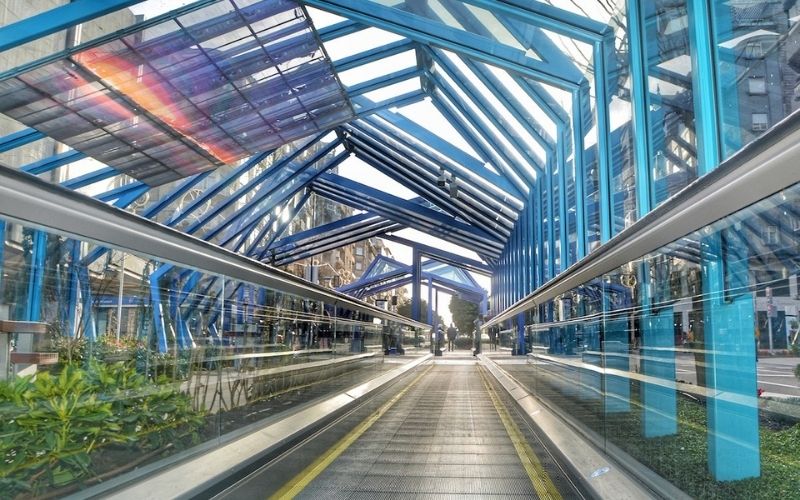Boosting urban connectivity and closing the last-mile gap
Elevators, escalators, and moving walks are gaining recognition as essential elements of urban public transport networks. They help extend the range of metro stations by closing the “last-mile” gap, and they can also be used independently to create entirely new urban connections.

Many cities want to expand the reach of their public transportation hubs and increase urban connectivity using low-energy transport solutions, thereby decreasing the need for fossil fuels and private automobiles. Cities like these need more elevators, escalators, and moving walks. Particularly in hilly cities, these mobility solutions can greatly reduce travel times from one level of the city to another. They can also create entirely new connections or more convenient paths to the local public transport network. Not only do these mobility solutions help reduce traffic, but they also improve mobility for all – including seniors and the disabled – while giving pedestrians improved access to local businesses.

The last mile: extending the reach of public transport hubs
In the field of transportation planning, the so-called “last mile” or (more specifically) the “first and last mile” is the distance between one’s point of departure or destination and the nearest public transport hub. If this distance is too great, people will choose to use a private car instead of public transportation.
This is where vertical transportation solutions like inclined elevators (similar to funiculars), can help – particularly in hilly cities where height presents an additional last-mile barrier. These people-moving solutions enjoy a high level of acceptance among citizens, especially among those who require barrier-free access. Plus, using these solutions can help cut back air pollution: they run on electricity and help curb the use of combustion vehicles.



Increasing connectivity in cities
Solutions like elevators and escalators can even be used to create completely new connections. In Vigo, Spain, the people-moving solutions go beyond the last mile: they are often the primary means of travel in this hilly city. The city’s “Vertical Vigo” program aims to create approximately 3 kilometers of new vertical connections, which actually provide for faster travel than cars, which have to follow long, winding roads to move uphill.
Some cities with long, gradual uphill climbs, such as Vitoria-Gasteiz in Spain, can benefit from moving walks. In this city, beautifully framed moving walks help increase access to the medieval quarter of the Basque capital city.
They can also be attractions in and of themselves. The moving walks in the Gran Via in Vigo, Spain are covered by glass roofing with a rainbow-colored framework and lined with plenty of plants and public benches.


Closing transportation gaps in northern Spain

The regions in the north of Spain all share a common feature: a rugged landscape with many hills, valleys, and steep climbs. Even the cities share this striking topography. As beautiful as those features can be, they are also barriers that can make it difficult to access basic services and shopping areas. That’s where vertical public mobility is stepping in to help.
In addition to elevators, escalators, and moving walks, this region has installed multiple “inclined elevators.” These elevators look similar to funiculars but function more like elevators in a technical sense. Whatever vertical mobility solution is used, it must also be specially prepared to withstand the often harsh marine conditions in the north of Spain.
Inclined elevator in Zurbaranbarri (Bilbao), Spain
The populous Bilbao neighborhood of Zurbaranbarri has very steep slopes, which prevent the mobility of an aging population. As a result, the city council decided to install an inclined elevator, but they also wanted to give it some local flair: The 25-person cabin was designed in the shape of a letter B, creating a new characteristic trademark for the Bilbao metropolitan transport service.
The elevator features 3 stops along a 64-meter track that reaches a height of 27 meters. It was inaugurated in June 2010, and it is still used by a large number of people as the preferred means of transport to the nearby underground line next to the lower stop of the elevator.

Inclined elevator in Rio de la Pila (Santander), Spain
A steep slope previously separated the upper districts of Santander from the city center. The installation of an inclined elevator was therefore a high priority as the slope prevented free mobility and connectivity. Inaugurated in July 2008, the 20-person cabin travels up 38 meters, making four stops along a distance of 78 meters. It offers a beautiful panoramic view and air conditioning to avoid intense heat in the summer.


Unsung heroes of urban transport
All too often, people forget the major role played by elevators, escalators, and moving walks in transporting us to our destinations. They act as last-mile feeders for public transport; move us around buildings, airports, and shopping centers; and now, it is becoming more and more common to see them used as methods of transportation in their own right that help us reduce our dependence on cars in dense urban areas.

